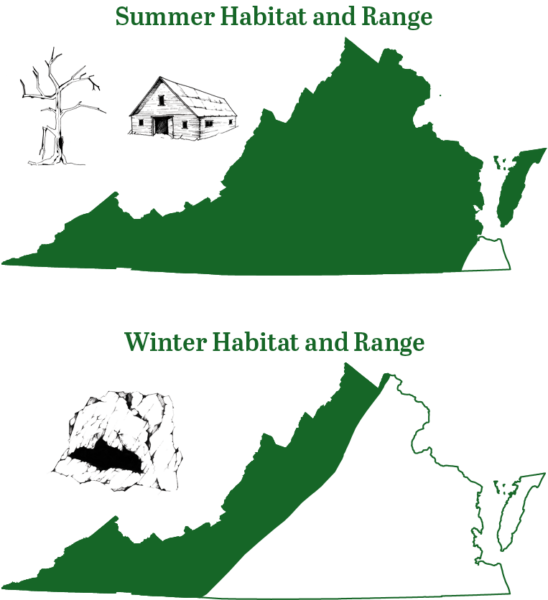Fact File
Scientific Name: Myotis lucifugus
Classification: Mammal, Order Chiroptera
Conservation Status:
- Species of Greatest Conservation Need-Tier 1a on the Virginia Wildlife Action Plan
Identifying Characteristics
The little brown bat was one of the most common bats found in Virginia before the outbreak of white-nose syndrome. Adults measure approximately 3.2–3.8 inches in length and weigh 0.2–0.45 ounces. The little brown bat is similar in size to many other bats in the region, having a wingspan of 8.7–10.7 inches. It is distinguishable from other Myotis by its large feet with heavily furred toes. The back fur is dark brown with much lighter coloration ranging from gray to white on the underside.
Habitat
It commonly hibernates in the many caves located in the western part of the state. During the warmer months females form maternity colonies while most adult males remain relatively solitary during this time of year. The little brown bat is common in most habitat types from city to suburban to forested areas.
Diet
Midges are a staple of their diet, but tiny flies, moths, mosquitoes, and beetles are also readily consumed.
Distribution:
The little brown bat can be found throughout Virginia except for a few portions of southeast Virginia.

Reproduction
After giving birth, lactating females seem to have a preference for larger prey items such as beetles. Little brown bats can be observed feeding over water, flying regular patterns through swarms of insects. Mating takes place during the fall, and a single pup is born in the spring. Maternity colonies are frequently found in manmade structures such as old buildings, churches, and bridges and may consist of several thousand individuals.
Conservation
White-nose syndrome is the primary threat to this species. Protection of hibernacula and maternity colonies are conservation priorities.
Last updated: August 14, 2024
ShopDWR
Order your copy of A Guide to the Bats of Virginia, along with more gear, guides, and gifts!
Visit ShopDWRThe Virginia Department of Wildlife Resources Species Profile Database serves as a repository of information for Virginia’s fish and wildlife species. The database is managed and curated by the Wildlife Information and Environmental Services (WIES) program. Species profile data, distribution information, and photography is generated by the Virginia Department of Wildlife Resources, State and Federal agencies, Collection Permittees, and other trusted partners. This product is not suitable for legal, engineering, or surveying use. The Virginia Department of Wildlife Resources does not accept responsibility for any missing data, inaccuracies, or other errors which may exist. In accordance with the terms of service for this product, you agree to this disclaimer.

